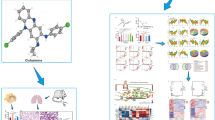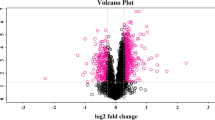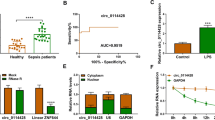Abstract
Background
Acute respiratory distress syndrome (ARDS) is characterized by refractory hypoxemia caused by accumulation of pulmonary fluid, which is related to inflammatory cell infiltration, impaired tight junction of pulmonary epithelium and impaired Na, K-ATPase function, especially Na, K-ATPase α1 subunit. Up until now, the pathogenic mechanism at the level of protein during lipopolysaccharide- (LPS-) induced ARDS remains unclear.
Methods
Using an unbiased, discovery and quantitative proteomic approach, we discovered the differentially expressed proteins binding to Na, K-ATPase α1 between LPS-A549 cells and Control-A549 cells. These Na, K-ATPase α1 interacting proteins were screened by co-immunoprecipitation (Co-IP) technology. Among them, some of the differentially expressed proteins with significant performance were identified and quantified by liquid chromatography-tandem mass spectrometry (LC–MS/MS). Data are available via ProteomeXchange with identifier PXD032209. The protein interaction network was constructed by the related Gene Ontology (GO) and Kyoto Encyclopedia of Genes and Genomes (KEGG) analysis. Several differentially expressed proteins were validated by Western blot.
Results
Of identified 1598 proteins, 89 were differentially expressed proteins between LPS-A549 cells and Control-A549 cells. Intriguingly, protein–protein interaction network showed that there were 244 significantly enriched co-expression among 60 proteins in the group control-A549. while the group LPS-A549 showed 43 significant enriched interactions among 29 proteins. The related GO and KEGG analysis found evident phenomena of ubiquitination and deubiquitination, as well as the pathways related to autophagy. Among proteins with rich abundance, there were several intriguing ones, including the deubiquitinase (OTUB1), the tight junction protein zonula occludens-1 (ZO-1), the scaffold protein in CUL4B-RING ubiquitin ligase (CRL4B) complexes (CUL4B) and the autophagy-related protein sequestosome-1 (SQSTM1).
Conclusions
In conclusion, our proteomic approach revealed targets related to the occurrence and development of ARDS, being the first study to investigate significant differences in Na, K-ATPase α1 interacting proteins between LPS-induced ARDS cell model and control-A549 cell. These proteins may help the clinical diagnosis and facilitate the personalized treatment of ARDS.
Graphical Abstract

Similar content being viewed by others
Introduction
Acute respiratory distress syndrome (ARDS) is a potentially fatal clinical syndrome that occurs as a result of diversified pulmonary and extrapulmonary factors, characterized by excessive lung inflammatory response, impaired tight junction of pulmonary epithelium, decreased pulmonary gas exchange ability and reduced alveolar fluid clearance (AFC) of the lungs with consequent refractory hypoxemia [1]. Effective removal of excess edema fluid in the alveoli and maintenance of dry alveolar space are the main ways to relieve ARDS [2]. The apically-located epithelial Na+ channel (ENaC) and sodium pump, namely Na, K-ATPase, on the basolateral surface of alveolar type II epithelial cells (AT II) mediated sodium ion transport is the main dynamic of AFC [1) using the Co-IP and LC–MS/MS technology. In this study, the FDR of polypeptide and protein levels were all controlled at 0.01.
Bioinformatics analysis
Enrichment of gene ontology (GO) terms was measured [ The datasets supporting the conclusions of this article are included within the article and its additional files. Acute respiratory distress syndrome Acute lung injury Intensive care unit Liquid chromatography-tandem mass spectrometry Affinity purification mass spectrometry Co-immunoprecipitation mass spectrometry Alveolar type II epithelial cells Lipopolysaccharide Apically-located epithelial Na + channel Human non-small cell lung cancer cell line/Human AT II cell line Alveolar fluid clearance Gene Ontology Kyoto Encyclopedia of Genes and Genomes Griffiths MJD, Mcauley DF, Perkins GD, Barrett N, Blackwood B, Boyle A, Chee N, Connolly B, Dark P, et al. Guidelines on the management of acute respiratory distress syndrome. BMJ Open Respir Res. 2019;6(1):e000420. Force ADT, Ranieri VM, Rubenfeld GD, Thompson BT, Ferguson ND, Caldwell E, Fan E, Camporota L, Slutsky AS. Acute respiratory distress syndrome: the Berlin definition. JAMA. 2012;307(23):2526–33. Zhang JL, Zhuo XJ, Lin J, Luo LC, Ying WY, **e X, Zhang HW, Yang JX, Li D, et al. Maresin1 stimulates alveolar fluid clearance through the alveolar epithelial sodium channel Na, K-ATPase via the ALX/PI3K/Nedd4-2 pathway. Lab Invest. 2017;97(5):543–54. Laffey JG, Matthay MA. Fifty years of research in ARDS. Cell based therapy for acute respiratory distress syndrome. Biology and potential therapeutic value. Am J Respir Crit Care Med. 2017;196(3):266–73. Cui X, **e Z. Protein interaction and Na/K-ATPase-mediated signal transduction. Molecules. 2017;22(6):990. Rocco PRM, Nieman GF. ARDS: what experimental models have taught us. Intensive Care Med. 2016;42(5):806–10. Wang Q, Zheng X, Cheng Y, Zhang YL, Wen HX, Tao Z, Li H, Hao Y, Gao Y, et al. Resolvin D1 stimulates alveolar fluid clearance through alveolar epithelial sodium channel, Na, K-ATPase via ALX/cAMP/PI3K pathway in lipopolysaccharide-induced acute lung injury. J Immunol. 2014;192(8):3765–77. Li J, Zhu HJ. Liquid chromatography-tandem mass spectrometry (LC-MS/MS)-based proteomics of drug-metabolizing enzymes and transporters. Molecules. 2020;25(11):2718. Wang Z, Wang H, Peng Y, Chen F, Zhao L, Li X, Qin J, Li Q, Wang B, et al. A liquid chromatography-tandem mass spectrometry (LC-MS/MS)-based assay to profile 20 plasma steroids in endocrine disorders. Clin Chem Lab Med. 2020;58(9):1477–87. Tyanova S, Temu T, Cox J. The MaxQuant computational platform for mass spectrometry-based shotgun proteomics. Nat Protoc. 2016;11(12):2301–19. **e C, Li B, Xu Y, Ji D, Chen C. Characterization of the global transcriptome for Pyropia haitanensis (Bangiales, Rhodophyta) and development of cSSR markers. BMC Genomics. 2013;14:107. Liu F, Li W, Li Z, Zhang S, Chen S, Su S. High-abundance mRNAs in Apis mellifera: comparison between nurses and foragers. J Insect Physiol. 2011;57(2):274–9. Morris JH, Knudsen GM, Verschueren E, Johnson JR, Cimermancic P, Greninger AL, Pico AR. Affinity purification-mass spectrometry and network analysis to understand protein-protein interactions. Nat Protoc. 2014;9(11):2539–54. Wu HQ, Baker D, Ovaa H. Small molecules that target the ubiquitin system. Biochem Soc Trans. 2020;48(2):479–97. Zhang W, Qiu W. OTUB1 Recruits Tumor Infiltrating Lymphocytes and Is a Prognostic Marker in Digestive Cancers. Front Mol Biosci. 2020;7:212. Wittekindt OH. Tight junctions in pulmonary epithelia during lung inflammation. Pflugers Arch. 2017;469(1):135–47. Zhang J, Vincent KP, Peter AK, Klos M, Cheng H, Huang SM, Towne JK, Ferng D, Gu Y, et al. Cardiomyocyte expression of ZO-1 is essential for normal atrioventricular conduction but does not alter ventricular function. Circ Res. 2020;127(2):284–97. Schwayer C, Shamipour S, Pranjic-Ferscha K, Schauer A, Balda M, Tada M, Matter K, Heisenberg CP. Mechanosensation of tight junctions depends on ZO-1 phase separation and flow. Cell. 2019;179(4):937-952e918. Ni J, Lu L, Chen H, Xu C, Cai W, Hong G, Zhao G, Lu Z. Plasma ZO-1 proteins predict the severity and outcome of sepsis: a prospective observational study. Clin Chim Acta. 2020;510:691–6. Lee TJ, Choi YH, Song KS. The PDZ motif peptide of ZO-1 attenuates Pseudomonas aeruginosa LPS-induced airway inflammation. Sci Rep. 2020;10(1):19644. Lin X, Barravecchia M, Kothari P, Young JL, Dean DA. beta1-Na(+), K(+)-ATPase gene therapy upregulates tight junctions to rescue lipopolysaccharide-induced acute lung injury. Gene Ther. 2016;23(6):489–99. Wan QQ, Wu D, Ye QF. Candidate genes as biomarkers in lipopolysaccharide-induced acute respiratory distress syndrome based on mRNA expression profile by next-generation RNA-Seq analysis. Biomed Res Int. 2018;2018:4384797. Liu X, Cui J, Gong L, Tian F, Shen Y, Chen L, Wang Y, **a Y, Liu L, et al. The CUL4B-miR-372/373-PIK3CA-AKT axis regulates metastasis in bladder cancer. Oncogene. 2020;39(17):3588–603. Song Y, Li P, Qin L, Xu Z, Jiang B, Ma C, Shao C, Gong Y. CUL4B negatively regulates Toll-like receptor-triggered proinflammatory responses by repressing Pten transcription. Cell Mol Immunol. 2021;18(2):339–49. Vishnupriya S, PriyaDharshini LC, Sakthivel KM, Rasmi RR. Autophagy markers as mediators of lung injury-implication for therapeutic intervention. Life Sci. 2020;260:118308. Liu Y, Shoji-Kawata S, Sumpter RM Jr, Wei Y, Ginet V, Zhang L, Posner B, Tran KA, Green DR, et al. Autosis is a Na+, K+-ATPase-regulated form of cell death triggered by autophagy-inducing peptides, starvation, and hypoxia-ischemia. Proc Natl Acad Sci U S A. 2013;110(51):20364–71. Wen XP, Zhang YZ, Wan QQ. Non-targeted proteomics of acute respiratory distress syndrome: clinical and research applications. Proteome Sci. 2021;19(1):5. Janga H, Cassidy L, Wang F, Spengler D, Oestern-Fitschen S, Krause MF, Seekamp A, Tholey A, Fuchs S. Site-specific and endothelial-mediated dysfunction of the alveolar-capillary barrier in response to lipopolysaccharides. J Cell Mol Med. 2018;22(2):982–98. We thank KangChen Bio-Tech, Shanghai, China, for their technical support for our experiments; The mass spectrometry proteomics data have been deposited to the ProteomeXchange Consortium via the PRIDE [1] partner repository with the dataset identifier PXD032209. This work was support by the Key project of Hunan Provincial Health Commission, China (grant numbers 202217012851). Design and conduct of the study: QiQuan Wan. Collection of the data: XuPeng Wen, YueZhong Zhang, He Huang, TaoHua Liu. Management, analysis and interpretation of the data: XuPeng Wen and QiQuan Wan. Manuscript preparation: XuPeng Wen. Critical revision: Guo Long, YueZhong Zhang, He Huang and TaoHua Liu. Final approval of the manuscript: All authors. Not applicable. All the authors have read and approved the manuscript for publication. All authors declare that there are no conflicts of interest. Springer Nature remains neutral with regard to jurisdictional claims in published maps and institutional affiliations. Table S1. Sample grou**. Table S2. Experimental results and Statistics. Table S3. Summary of significant proteins identified in the study. Table S4. Top 20 up-regulated KEGG pathway analysis. Table S5. Results of group Control-A549–IgG-A549. Significant proteins annotation (show 50 if available). Table S6. Results of group LPS-A549–IgG-LPS. Significant proteins annotation (show 50 if available). Figure S1. Venn diagram of the different proteins in LPS-A549 vs. IgG-LPS. Figure S2. Venn diagram of the different proteins in control-A549 vs. IgG-A549. Figure S3. Enriched GO items of < C > in Control-A549 vs. IgG-A549. top axis is log10(adjust p-value), bottom axis is gene count. Figure S4. Enriched GO items of < C > in LPS-A549 vs. IgG-LPS. top axis is log10(adjust p-value), bottom axis is gene count. Figure S5. Enriched KEGG items of < T > in Control-A549 vs. IgG-A549. Figure S6. Enriched KEGG items of < T > in LPS-A549 vs. IgG-LPS. Figure S7. Control-A549--IgG-A549-STRINGdb-T-1. Figure S8. LPS-A549--IgG-LPS-STRINGdb-T-1. Open Access This article is licensed under a Creative Commons Attribution 4.0 International License, which permits use, sharing, adaptation, distribution and reproduction in any medium or format, as long as you give appropriate credit to the original author(s) and the source, provide a link to the Creative Commons licence, and indicate if changes were made. The images or other third party material in this article are included in the article's Creative Commons licence, unless indicated otherwise in a credit line to the material. If material is not included in the article's Creative Commons licence and your intended use is not permitted by statutory regulation or exceeds the permitted use, you will need to obtain permission directly from the copyright holder. To view a copy of this licence, visit http://creativecommons.org/licenses/by/4.0/. The Creative Commons Public Domain Dedication waiver (http://creativecommons.org/publicdomain/zero/1.0/) applies to the data made available in this article, unless otherwise stated in a credit line to the data. Wen, XP., Long, G., Zhang, YZ. et al. Identification of different proteins binding to Na, K-ATPase α1 in LPS-induced ARDS cell model by proteomic analysis.
Proteome Sci 20, 10 (2022). https://doi.org/10.1186/s12953-022-00193-3 Received: Accepted: Published: DOI: https://doi.org/10.1186/s12953-022-00193-3Availability of data and materials
Abbreviations
References
Acknowledgements
Funding
Author information
Authors and Affiliations
Contributions
Corresponding author
Ethics declarations
Ethics approval and consent to participate
Consent for publication
Competing interests
Additional information
Publisher’s Note
Supplementary Information
Additional file 1:
Rights and permissions
About this article
Cite this article
Keywords




